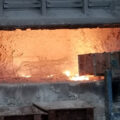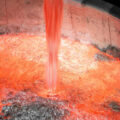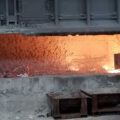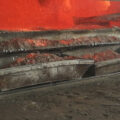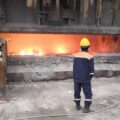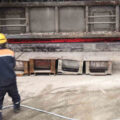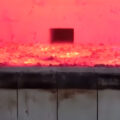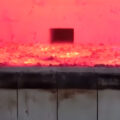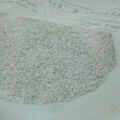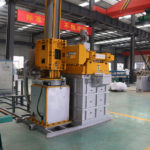After the aluminum alloy is completely smelted, there are many scum on the surface, mainly Al2O3 and other oxides. These small slag inclusions are heavier than molten aluminum, but have a lighter specific gravity after agglomeration. They float on the surface and need the Refining Process for Aluminum Alloy. The amount of slag cleaning agent is added according to 0.2% to 0.5%, and it is evenly sprinkled on the surface of the aluminum liquid, and it is uniformly stirred at a shallow level. Pick up the slag on the furnace door, close the furnace door and let it stand. On the one hand, the slag cleaning agent has a heating effect and can melt the aluminum liquid adhering to the scum. On the other hand, it can effectively separate the slag from the molten aluminum, which is beneficial to extract the aluminum slag. After a few minutes, the aluminum slag can be smoothly extracted from the furnace door.
Aluminum alloy smelting is a very complicated process. Different elements are inconsistent in burning degree. After slagging, before transferring the molten aluminum to the ladle, it is necessary to sample for physical and chemical analysis, so as to ensure that each element is within the qualified range before the aluminum water degassing and refining, otherwise it needs to be adjusted appropriately.

Refining Process for Aluminum Alloy
In the process of aluminum alloy smelting, the molten aluminum must be modified. The modification is carried out before refining. Before the molten aluminum is transferred from the melting furnace to the ladle, a Sr modifier is added at the bottom of the furnace, and it is added in the form of alloy, without directly adding metamorphic elements. Aluminum-strontium alloy rods are commonly used as modifiers. Sr is a long-acting modifier. The modification time can last for 6 to 8 hours, making the coarse flaky silicon refined into a fine structure and further improving the mechanical properties. This kind of deterioration effect is better than adding it in the smelting furnace and can reduce the deterioration. Burn and decline. After Sr is melted at the bottom of the furnace, use rotating degassing to stir evenly to reduce segregation. After Sr has deteriorated, the molten aluminum absorbs hydrogen faster and produces many pinholes. The residence time after refining should not be too long. If it exceeds 1h, it needs to be re-tested.
After the molten aluminum is transferred to the ladle, sprinkle the slag cleaning agent and stir deeply to remove the slag. Measure whether the temperature of the molten aluminum can reach the refining temperature. If the temperature is too high, it needs to be added to the furnace to cool down. If the temperature is lower, it needs to be electrified to increase the temperature. The refining temperature is controlled at 720-740 ℃. Sprinkle a small amount of slag cleaning agent on the surface until the adjustment is qualified. The degassing refining is mainly for degassing and hydrogen removal. Since the first deep stirring has removed most of the slag, but there is still a small amount of aluminum slag inside, so the second time Add a small amount of slag cleaning agent.

Rotary Degassing Refining Methods
The common methods of rotary degassing refining are degassing refining and powder spraying refining. The principle is to pass inert gas or refining agent to the bottom of the furnace. The refining agent is very light, and the inert gas or refining agent starts to rise from the bottom of the furnace. Remove the hydrogen and scum in the molten aluminum to achieve the purpose of purifying the molten aluminum. The deaerator used in degassing refining drives the flange plate through the motor, and the flange plate is connected to the graphite rotor to rotate. General graphite rotors have a relatively short life and are prone to corrosion and fracture. In this regard, graphite rotors are immersed in a medium under high temperature and pressure, and then sintered and solidified to increase their service life. This type of graphite mainly relies on imports and is costly.
The refining effect of rotating powder spraying is better, but it is easy to block the graphite rotor. In production, dry inert gas or high-purity nitrogen is used for refining. The gas is connected to the flange. The flange starts to rotate under the drive of the motor. The graphite rotor rotates with the flange at a speed of 400~600 r. /min, the flow of inert gas (argon) is controlled at 15-25 L/min, nitrogen is 20-40 L/min, and the pressure is (0.4±0.1) MPa. During the operation, first open the gas valve, and then slowly lower the deaerator until the distance between the graphite rotor of the deaerator and the bottom of the ladle furnace is 100~150 mm, and finally turn on the motor to start degassing and refining. The refining time is 10-20 min. . In order to avoid the vortex caused by the high-speed rotation of the graphite rotor, a baffle plate is installed on one or both sides of the graphite rotor to reduce the turbulence of the molten aluminum during the rotation. When the graphite rotor is degassing, the bubbles are small, the dispersion is high, and the effect is good. In this way, the degassing effect can be ensured, and no bubbles will break the surface oxide film to cause boiling, and avoid secondary inhalation.
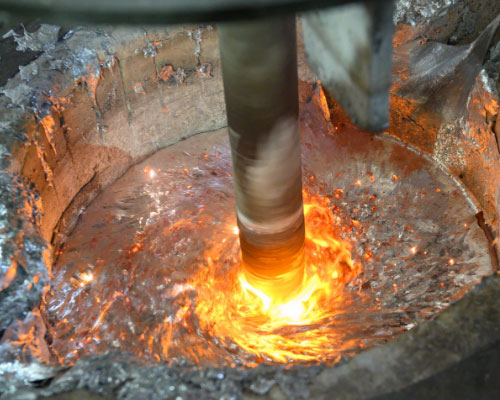
After the degassing is completed, turn off the motor, lift the graphite rotor away from the liquid surface, and then close the gas valve. Since the slag cleaning agent is added to the surface before degassing, the aluminum slag is floating on the surface during the degassing process, and the slag ash needs to be removed. Use a special tool to scoop out the filtrate in the casting ladle. It is recommended to pour it quickly and stably below 50 mm from the liquid surface Two dedicated crucibles. One of the crucibles is solidified under normal pressure; the other crucible is quickly covered with a bell jar and vacuumed. The vacuum pressure must reach 8 MPa, and the vacuuming time is 3 to 4 minutes. Put it in water to cool, take it out and wipe dry, press the normal pressure first and then Vacuum the density equivalent measurement. The smaller the density equivalent, the lower the hydrogen content of the molten aluminum, the better the degassing refining effect. Different products have different requirements on the density equivalent, and the density equivalent needs to be refined again if the density equivalent is unqualified.
The refining process for aluminum alloy is accompanied by the change of elements. For example, in the production process of A356, the modifier Sr is added in 0.025% before degassing, the Sr content after refining and degassing is 0.012%~0.02%, and the Sr content in castings is 0.008%~0.018 %. Physical and chemical analysis is required after refining, and adjustment is required for unqualified. Covering agent is sprinkled after both density equivalent and physical and chemical analysis are qualified. The function of the covering agent is to isolate the air and prevent oxidation. In the case of a short residence time, it is not necessary to sprinkle the covering agent. Before finally transferring, clean the covering agent and use it.


